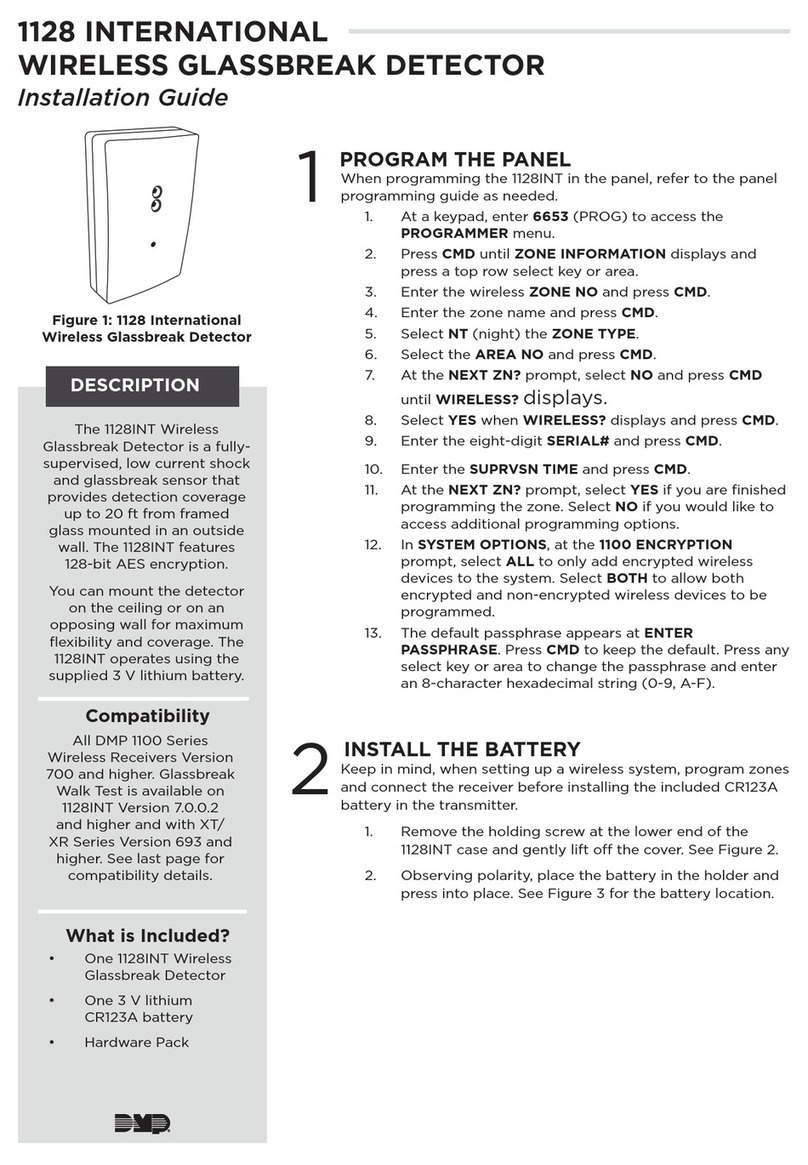
DESCRIPTION
Figure 1: 1122INT Wireless
Motion Detector
1PROGRAM THE PANEL
2INSTALL THE BATTERY
Compatibility
What is Included?
When programming the 1122INT in the panel, refer to the panel
programming guide as needed.
1. At a keypad, enter 6653 (PROG) to access the
PROGRAMMER menu. In ZONE INFORMATION, enter
the zone number. Press CMD.
2. Enter the zone name and press CMD.
3. Select NT (Night) as the ZONE TYPE.
4. Select the area.
5. At the NEXT ZONE prompt, select NO.
6. Select YES when WIRELESS? displays.
7. Enter the eight-digit SERIAL#. Press CMD.
8. Enter the SUPERVSN TIME and press CMD.
9. Choose whether to enable DISARM DISABLE (panel
firmware Version 672 and higher). Select YES to allow
the 1122INT to be disabled for Night and Exit zones
while the area is disarmed.
10. Choose either 2or 4for the PULSE COUNT. The pulse
count is the pulse inputs (trips) the 1122INT needs to
sense before going into alarm.
11. Choose either LOW or HIGH for the SENSITIVITY.
Selecting LOW may reduce false alarms for
installations in harsh environments.
12. Choose whether to enable PET IMMUNITY (panel
firmware Version 672 and higher).
13. At the NEXT ZONE prompt, select YES if you are
finished programming the zone. Select NO if you
would like to access additional programming options.
14. In SYSTEM OPTIONS, at the 1100 ENCRYPTION
prompt, select ALL to only add encrypted wireless
devices to the system. Select BOTH to allow both
encrypted and non-encrypted wireless devices to be
programmed.
15. The default passphrase appears at ENTER
PASSPHRASE. Press CMD to keep the default. Press
any select key or area to change the passphrase and
enter an 8-character hexadecimal string (0-9, A-F).
The 1122INT Wireless PIR Motion
Detector uses passive infrared
technology to detect motion in
a wide angle lens pattern. The
1122INT features 128-bit AES
encryption.
The motion detector features
a wall tamper, internal case
tamper, survey LED, low battery
indicator, adjustable sensitivity,
and pulse count.
Disarm/disable and pet
immunity up to 55lbs are
available for panels with
firmware Version 672 and
higher.
To extend battery life, the
1122INT is equipped with a
30-second sleep timer that
restarts on every motion
detection. This functionality
allows the 1122INT to wake
up after 30seconds with no
motion detected unless disarm/
disable is active.
Use only a 3.0V lithium battery, DMP Model CR123A, or the
equivalent battery from a local retail outlet. When setting up
a wireless system, program zones and connect the receiver
before installing batteries in the transmitters.
1. Remove the holding screw at the lower end of the
1122INT case and gently lift o the cover.
2. Observing polarity, place the battery in the holder and
press into place. See Figure2 for the battery location.
All DMP 1100INT Series
Wireless Receivers (Version
700 or higher) and burglary
panels Version 693 and
higher. See the last page for
compatibility details.
• One 1122INT Wireless PIR
Motion Detector
• One 3.0V Lithium
CR123A Battery
1122 INTERNATIONAL
WIRELESS MOTION DETECTOR
Installation Guide























